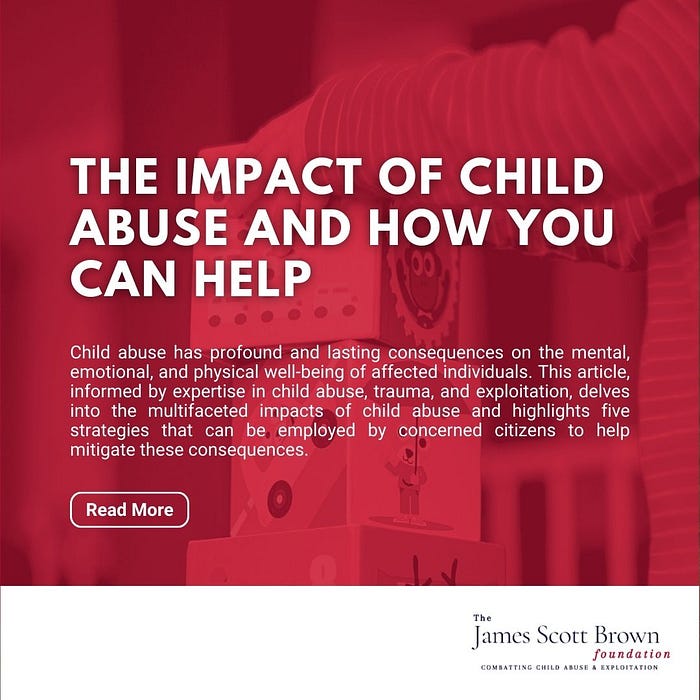The Impact of Child Abuse and How You Can Help by James Scott Brown Foundation
by James Scott Brown Foundation

Abstract:
Child abuse has profound and lasting consequences on the mental, emotional, and physical well-being of affected individuals. This article, informed by expertise in child abuse, trauma, and exploitation, delves into the multifaceted impacts of child abuse and highlights five strategies that can be employed by concerned citizens to help mitigate these consequences. By understanding the effects of abuse and taking action, individuals can play a crucial role in promoting healing and preventing further harm.
1.Understanding the Consequences of Child Abuse:
Child abuse has been associated with a myriad of adverse outcomes, including psychological disorders, cognitive impairments, social difficulties, and increased risk of engaging in self-destructive behaviors (Norman et al., 2012). By comprehending the magnitude of these consequences, individuals can better appreciate the urgency of addressing this pressing issue.
2. Recognize and Report Suspected Abuse:
Learn to identify the signs of child abuse and familiarize yourself with the appropriate reporting channels in your area. Timely intervention is crucial to preventing further harm and promoting the well-being of affected children (Gilbert et al., 2009).
3. Support and Volunteer with Local Organizations:
Assist local organizations and NGOs dedicated to the prevention of child abuse or the provision of support services for affected children. Volunteering your time, skills, or resources can significantly contribute to the effectiveness of these organizations’ efforts (Lemon et al., 2011).
4. Foster a Safe and Supportive Environment:
Create a safe and supportive environment within your family and community that encourages open communication about child abuse. By fostering a culture of trust and understanding, you can empower children to speak up if they have experienced or witnessed abuse (Wurtele, 2009).
5. Advocate for Policy Changes and Improved Services:
Engage in advocacy efforts to promote the adoption of evidence-based policies, programs, and services that address child abuse prevention and intervention. Supporting policy reform and the development of comprehensive services can contribute to lasting change in the fight against child abuse (Chaffin et al., 2011).
Conclusion:
The devastating impacts of child abuse necessitate collective efforts to promote healing and prevent future harm. By employing the strategies outlined above, individuals can make a meaningful difference in the lives of children affected by abuse and contribute to a safer, more supportive society.
References:
Chaffin, M., Friedrich, B., Kelleher, K., & Shelley, G. (2011). Looking to the future of child abuse and neglect prevention in the United States. Child Abuse & Neglect, 35(12), 1066–1074.
Gilbert, R., Widom, C. S., Browne, K., Fergusson, D., Webb, E., & Janson, S. (2009). Burden and consequences of child maltreatment in high-income countries. The Lancet, 373(9657), 68–81.
Lemon, S. C., Zapka, J., & Clemow, L. (2011). Health behavior change among women with recent familial diagnosis of breast cancer. Preventive Medicine, 53(1–2), 85–91.
Norman, R. E., Byambaa, M., De, R., Butchart, A., Scott, J., & Vos, T. (2012). The long-term health consequences of child physical abuse, emotional abuse, and neglect: A systematic review and meta-analysis. PLoS Medicine, 9(11), e1001349.
Wurtele, S. K. (2009). Preventing sexual abuse of children in the twenty-first century: Preparing for challenges and opportunities. Journal of Child Sexual Abuse, 18(1), 1–18.
Read more at the James Scott Brown Foundation.
Comments
Post a Comment